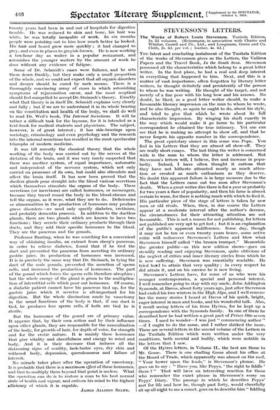STEVENSON'S LETTERS.
The Works of Robert Louis Stevenson. Tusitala Edition. In 35 volumes. (Heinemann, in association with Chatto and Winding, Cassell and Co., Ltd., and Longman, Green and' Co, Cloth, 2s. 6d. per vol. ; leather, 4s. 6d.) THE latest and concluding instalment of the Tusitala Edition of the works of Stevenson gives us the Letters, the Vailima Papers and the Travel Book, In the South Seas. Stevenson
possessed all the characteristics which belong to a great letter writer. In the first place, he had a real and deep interest in everything that happened to him. Next, and this is a matter of vast importance, often forgotten by literary letter writers, he thought definitely and persistently of the person to whom he was writing. He thought of the target, and not merely of a fine pose with his long bow and his arrows. -No
doubt, he liked, as a good letter writer should, to make a favourable literary impression on the man to whom he wrote, and he also thought, as again he ought to do, about his style, and tried to give that which he wrote about its full characteristic impression. By winging his shaft exactly in the way which would make it go home to his particular correspondent he obtained the true intimacy. Yet one can see that he is making no attempt to show off, and that he
never forgets his opposite number in the correspondence. The great epistolary sinner in this sense was Pope. You feel in his Letters that they are almost all show-off. They are really short essays. The last thing the writer is concerned with is the man to whom the letter is addressed. But Stevenson's letters will, I believe, live and increase in popu- larity. Indeed, I have often thought it curious that they have not hitherto attracted nearly as much atten- tion or created as mach enthusiasm as they deserve.
No doubt this apparent failure is in large measure due to the fact that the Letters came out too soon after Stevenson's death. When a great writer dies there is for a year or probably for two years a flare of popularity, and then his fame is almost certain to wane, for there is nothing much with which to feed it. His particular piece of the stage of letters is taken by new men or old rivals. When, then, in due course the Letters appear at a moderate interval after the author's decease, the circumstances for their attracting attention are not favourable. This is not a reason for not publishing, for letters not published are very apt to get lost ; but it is an explanation of the public's apparent indifference. Some day, though
it may not be ten or even twenty years hence, some active critic will rediscover Stevenson's Letters and blow what Stevenson himself called "the brazen trumpet." Meanwhile
the greater public—as this new edition shows—goes on steadily reading and enjoying Stevenson, quite oblivious of the neglect of critics and inner literary circles from which he is now suffering. Stevenson was essentially readable. He tried hard to attain that very quality ; in every respect he did attain it, and on his success he is now living.
Stevenson's Letters have, for some of us who were his younger contemporaries, a special and personal interest. I well remember going to stay with my uncle, John Addington Symonds, at Davos, about forty years ago, just after Stevenson had ended his two winters in the High Alps, and I well remem- ber the many stories I heard at Davos of his quick, bright, eager interest in Men and books, and his wonderful talk. Also, I recall seeing letters of his from Hyeres, for he kept up a
correspondence with the Symonds family. In one of them he described how he had written a great part of Prince Otto seven
times. I used to wonder—I was just " commencing author " —if I ought to do the same, and I rather shirked the issue. There are several letters in the second volume of the Letters in the Tusitala Edition which were written under the very conditions, both mental and bodily, which were notable in the letters that I saw.
Of the Hyeres letters, in Volume IL, the best are those- to Mr. Gosse. There is one chaffing Gosse about his office at the Board of Trade, which apparently was almost on the roof. " Your bower upon the leads," is Stevenson's phrase. He goes on to say : " Have you, like Pepys, ' the right to fiddle' there ? " That will have an interesting reaction for those who remember the exact phrase in Stevenson's essay on Pepys' Diary. The passage in which he describes Pepys' zest for life and how he, though past forty, would cheerfully sit up all night to see a comet, goes on to describe him " fiddling
on the leads." The phrase evidently held Stevenson tight, for when he analyzes Pepys' poignant alarm at the appearance of Berkeley's Apology for the Sect called Quakers, he notes that this alarm was caused by his fear lest he should be converted. How awful a prospect was opened before the diarist ! No more singing with Mercer, no more amours, no more " fiddling on



















































 Previous page
Previous page